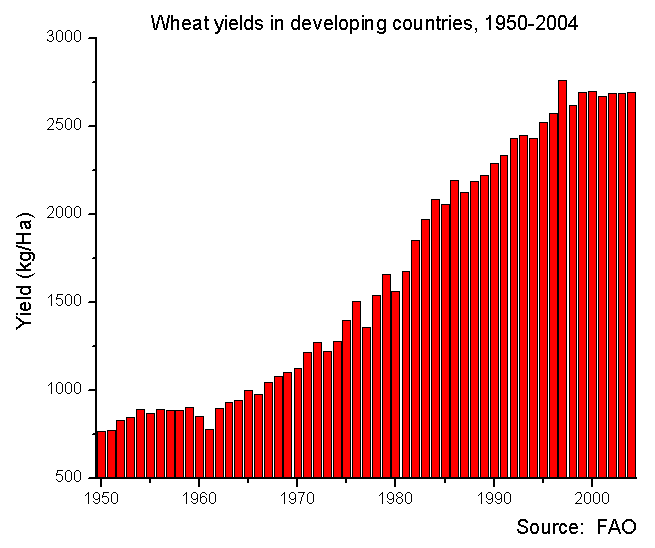Course:ECON371/UBCO2009WT1/Group 7/Article2
Norman Borlaug creates a new hypothesis that is “Borlaug hypothesis”, which increasing the productivity of agriculture on the best farmland can help control deforestation by reducing the demand for new farmland. Nowadays the world population is keeping increasing that result the demand of food (wheat) increasing, and then increasing profits from high-yield production may also induce cropland expansion in any case.
Deforestation will cause soil erosion. There are also likely to affect the local climate, generally tends to drought. The natural geographical changes in the environment will naturally affect the survival and development of local biotechnology, biological species may be reduced.
The wheat was growing year by year and this help the developing counties solve the problem of the hunger that is benefit to the society. The government can reduce the cost on food support at the same time make profit from the farmland owners.
Without the "Green Revolution" the demand of the food is increasing but the supply will not change. There will be a higher level of consumer surplus because more is being bought at a higher price than before. With the "Green Revolution" the demand of the food is still increasing also the supply will increase a lot. There will be increase in the quantity traded in the market. As a result, there is an increase in consumer welfare by a rise in consumer surplus. Because the wheat is elastic product when the price goes down the total revenue will go up. The curve is flatter that people pay closer that they are willing to pay. Therefore, the “Green Revolution” increases the productivity to satisfy people’s demand also lower the price of the wheat that causes the increase the total revenue of the wheat market.
From the biological perspective that the “Green Revolution” increasing disease resistance through multiline varieties. From the economic perspective that the “Green Revolution” decreasing the capital, land and labor; increase the output rapidly.
Prof's Comments
I would like to see a lot more use of economic concepts in the analysis. You should check some of the contributions by other groups. As I briefly outlined in class, the green revolution was in essence a shift down in the supply curve. This made more food available at lower cost, and was able to keep food production growing at pace with population growth - at least until recently. The article alludes to the impact on the land market, where because of how much production increased, the demand for land fell, thus enabling more wild areas to be protected. This is how the green revolution served to protect biodiversity.
